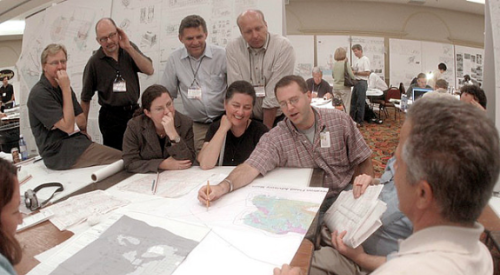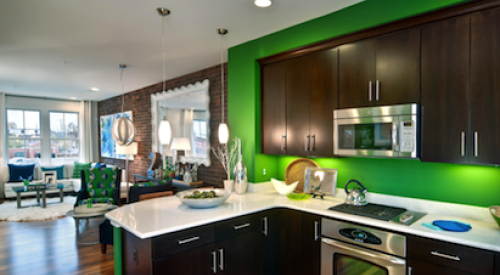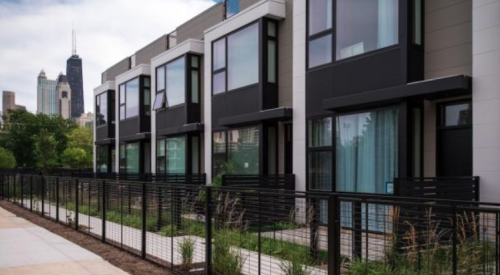| Two-thirds of Bradfield's sales have been homes, like the Oxford II shown here in the foreground, with either a porte cochere, a rear garage, or both.
|
When 500 people showed up for the grand opening of Bradfield Village 12 months ago, builder Clark Wilson got the first reinforcement of his theory that nostalgic neighborhoods might sell well in the Austin, Texas, market. Today, with 96 houses closed and 32 more sold and under construction, he's sure of it.
Wilson bought the 80-acre site in south suburban Buda in 1999 and had to donate 40 acres for a city park to get his development approved. His plan was to put 160 single-family homes, most base-priced well below $200,000, on the remaining 40 acres.
Bradfield Village is not a true traditional neighborhood development. It has no retail or commercial component, and no alleys. While it is designed to encourage walking, the only real pedestrian destination is that adjacent city park. Houses are front-loaded, but many have driveways down the sides of lots to reach detached garages behind the houses. However, there are no granny flats built into the spaces above the garages, as in a true TND. Still, it looks and feels like a small Texas town in pre-World War II America.
"We bought the site with a grid plan in place that maximized the number of lots," says Wilson. "That's the way they make money on the land, buy by the acre and sell by the lot. We immediately discarded that plan and brought in land planner Don Bosse, who is a real TND proponent, to do a new land plan that focuses attention on the lakes in the city park we donated at the rear of the property. Then we set out to create a neighborhood that would add real value to each of the houses."
| Bradfield Village is a modified Traditional Neighborhood Development, with front porches on all homes and detached garages behind many. But there's no commercial or retail compenent and no al-leys. Gazebo sets the nostalgic tone.
|
Wilson and Bosse turned the street leading to the largest lake into a boulevard, Crescent Drive, with a park in the median. Wilson built three model homes on one end of the street, but he also built spec homes on eight of the remaining nine lots on the street, and placed a gazebo on the vacant one. The street Bosse and Wilson created has the quiet, laid-back feel of the 1950s. Front porches face the street behind white picket fences. The street leads to the park and lakes.
"We knew we had to show a full street scene," says Wilson. "If we'd only done the three models, it would have been a tough sell because we were asking for more money than the Buda market was used to, and all they'd see was that we'd taken the brick fronts off the houses and put on front porches. We had to demonstrate the real value we are creating in the neighborhood."
To emphasize the point that he was creating an old fashioned, pedestrian-oriented neighborhood, Wilson produced a grand opening event that turned into a marketing bonanza.
"We created a 'homecoming' weekend like they have in all the little, rural Texas towns," Wilson says. "We hired actors to play the residents. We had a barbecue going in the park in the median. We put old cars in all the driveways. We had a homecoming queen, and lots of contests -- yoyo contests, kite-flying contests, etc. We had kids playing touch football in the park."
That was the event that brought out 500 people. But to sell houses, Wilson had to have more than a nostalgic neighborhood. He had to have houses that would be fun to live in. That means floor plans to match modern lifestyles.
Read Part II of this article.
Modified TND A Hit In Austin: Part II











